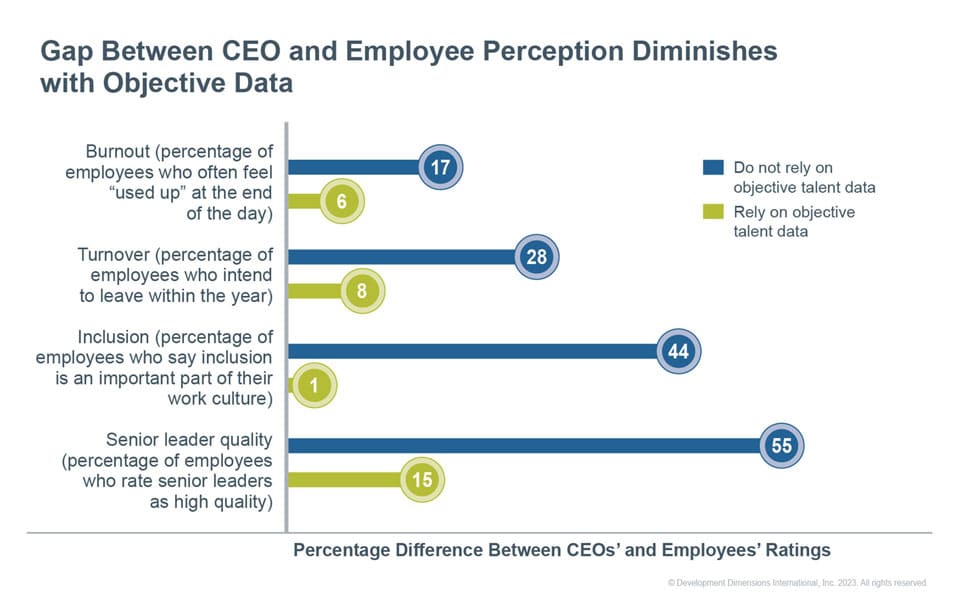Three Reasons You’re Disconnected From Your Team & How to Close the Gaps

As leaders, most of us like to think we’re quite plugged-in with our team. Yet, the reality is if CEOs were contestants on Family Feud, they’d be losing — misjudging the popular opinion of their workplace. When asked to rate their organization’s performance in areas such as burnout, turnover, inclusion and senior leader quality, CEOs’ responses differ dramatically from their employees.
While your company might not operate with the top-down hierarchy that was common two decades ago, having a finger on the pulse with your employees is still much harder than it sounds. Despite most CEOs’ best efforts to be hands-on, transparent, lead with vulnerability and be a partner for their team, the fact is, you’re still the boss, and that alone sets you apart. Any leadership role naturally creates some level of perceived separation that often manifests in leaders not getting the full picture.
When things aren’t entirely as they seem from your point of view in the C-suite, those disconnects can prevent you from making fully informed decisions, or worse, create blind spots that become competitive liabilities.
To prevent those perception-versus-reality issues from becoming a problem, here are three key drivers that can create disconnects and ways you can bridge the gaps to build a more cohesive, empathetic and effective organization.
- Lack of objective data
Too often, CEOs rely on their own perceptions of how their team is doing through day-to-day interactions. But people often put on a happy face when the boss is around — they don’t want to be perceived as unhappy because they fear it might risk them being reprimanded, or worse. When your position of authority fosters inauthenticity among your team, it’s easy to overestimate how well things are going.That’s especially true when it comes to fostering inclusion. According to DDI’s CEO Leadership Report 2023, 85% of CEOs say they feel prepared to foster an inclusive culture, yet less than a fourth of frontline managers say inclusion is a strong part of their culture. This research also shows that underrepresented talent, like women and minorities, are 1.5X more likely to feel they have to leave their organizations for career advancement.
Yet, when CEOs based their perception of their organization’s inclusivity on objective data from employee assessments and tests, the perception gap between them and their employees shrank from a 44% difference to just a 1% difference.
Just like you wouldn’t rely on a gut feeling to make capital investment decisions without hard data, CEOs can’t rely on their subjective perception when it comes to gauging employees’ level of satisfaction, inclusion or engagement. It’s essential to use frequent surveys, questionnaires and direct feedback to gain empirical, authentic insight into how your employees really feel.
- Poor frontline management
When CEOs aren’t confident in their frontline managers, they tend to be more pessimistic about the future of their organization. Only about one in three CEOs with low-quality frontline leaders feel prepared to meet new business challenges like artificial intelligence (AI) and emerging technology, and only half feel they have what it takes to capture organizational knowledge before it’s lost, or to prevent employee burnout — all serious risks to business continuity and growth. This lack of confidence is often a sign that CEOs haven’t invested in their frontline leaders enough to ensure they’re prepared to meet emerging challenges. To address this disconnect, CEOs should rely more on mid-level managers to set the tone and expectations for their teams, to serve as mentors for frontline managers and create a direct link between them and the C-suite. CEOs must also prioritize leadership development across the board and collaborate with HR closely to develop leadership skills at all levels, which includes assessing training needs with empirical data and investing appropriately. - Fracturing at the top
It’s tough to maintain connection with your team when the executive team itself isn’t on the same page. In an alarming trend, executive teams have become increasingly fractured since the pandemic, as many companies fail to implement sound executive succession strategies. More than two-thirds of CEOs now say their executive team is ineffective at driving strategy, and that problem trickles down, creating lack of confidence in the executive team among senior and mid-level leaders. This lack of C-suite cohesiveness creates a culture of confusion, misalignment and chaos. In companies with ineffective executive teams, leaders are 6.5X less likely to feel clear expectations have been set for them, 5X less likely to say their organization handles change well and 2.3X less likely to feel they can succeed at navigating ambiguity and uncertainty — the hallmark of modern business.To counter this disconnect at the top, and foster confidence and connection across the organization, CEOs must prioritize executive team cohesion as a whole. Even an executive team with many high-performing individuals could fail if you don’t consider the group dynamic. Use teambuilding tactics to optimize group dynamics and create consensus on strategic priorities. Align on key business objectives and use those to guide strategy and decision-making across the organization. For example, lean-in to using scorecards and objective metrics to benchmark proposed new initiatives against agreed-upon objectives to ensure they’re actually driving business strategy, rather than just pet projects.
When the team at the top is working together from the same playbook, that sets the tone for the rest of the organization and reinforces collaboration and cohesion by modeling the behavior you want to see in the rest of the team.
As with solving any business problem, the first step to overcoming a disconnect between you and your team is to objectively identify the root causes creating those gaps. By addressing those disparities, CEOs can create a more collaborative and effective team culture that prioritizes inclusivity, keeps the workforce engaged and drives better performance — both individually and for the organization.


Written by Stephanie Neal.
Have you read?
The World’s Top 10 Highest-Paid Wealth Management Executives.
CEO compensation: Highest paid chief executive officers in the United States.
Highly-Paid Entertainment Chief Executives (Averaged $31.66 Million).
Highest-paid health insurance CEOs.
Most Powerful Companies in Australia, 2023.
Bring the best of the CEOWORLD magazine's global journalism to audiences in the United States and around the world. - Add CEOWORLD magazine to your Google News feed.
Follow CEOWORLD magazine headlines on: Google News, LinkedIn, Twitter, and Facebook.
Copyright 2025 The CEOWORLD magazine. All rights reserved. This material (and any extract from it) must not be copied, redistributed or placed on any website, without CEOWORLD magazine' prior written consent. For media queries, please contact: info@ceoworld.biz








